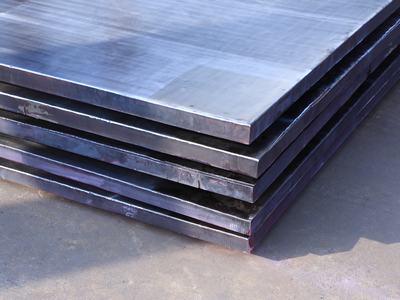

Duplex Stainless Steel 2205 |

ASTM A240/A240M--01 Duplex Stainless Steel 2205 is a duplex stainless steel consisting of 21% chromium, 2.5% molybdenum and 4.5% nickel-nitrogen alloy. It has high strength, good impact toughness and good overall and local resistance to stress corrosion. The 2205 duplex stainless steel has twice the yield strength of austenitic stainless steel. This feature allows the designer to reduce the weight of the product when designing the product, making this alloy more cost-effective than the 316,317L. This alloy is especially suitable for use in the temperature range of -50 / +600 . Alloys that are outside this temperature range can also be considered for this alloy, but with some limitations, especially when applied to welded structures. Features: 1. Duplex stainless steel 2205 alloy Compared with 316L and 317L austenitic stainless steel, 2205 alloy has superior performance in resisting plaque and crevice corrosion. It has high corrosion resistance, compared with austenite. The coefficient of thermal expansion is lower and the thermal conductivity is higher. 2. Duplex stainless steel 2205 alloy has twice the compressive strength compared with austenitic stainless steel. Compared with 316L and 317L, the designer can reduce the weight. The 2205 alloy is particularly suitable for use in the temperature range of -50/ +600, and can be used for lower temperatures under severe restrictions (especially for welded structures). 2205 duplex stainless steel is a duplex stainless steel consisting of 22% chromium, 3% molybdenum and 5-6% nickel nitrogen. Compared with 316L and 317L austenitic stainless steel, 2205 alloy has superior performance in pitting corrosion resistance and crevice corrosion. Application field Pressure vessels, high pressure storage tanks, high pressure pipelines, heat exchangers (chemical processing industry). Oil and gas pipelines, heat exchanger fittings. Sewage treatment system. Pulp and paper industry classifiers, bleaching equipment, storage processing systems. Rotary shafts, press rolls, blades, impellers, etc. in high-strength, corrosion-resistant environments. Ship or truck cargo box Food processing equipment Corrosion resistance Uniform corrosion Due to chromium content (22%), molybdenum (3%) and nitrogen content (0.18%), the corrosion resistance of 2205 is superior to 316L and 317L in most environments. Local corrosion resistance The content of chromium, molybdenum and nitrogen in 2205 duplex stainless steel makes it highly resistant to pitting corrosion and crevice corrosion in oxidizing and acidic solutions. Stress corrosion resistance The two-phase microstructure of stainless steel helps to improve the resistance to stress corrosion cracking of stainless steel. Chloride stress corrosion occurs in austenitic stainless steels in the presence of certain temperatures, tensions, oxygen and chlorides. Since these conditions are not easily controlled, the use of 304L, 316L and 317L is limited in this respect. Corrosion resistance The high strength and corrosion resistance of 2205 duplex steels provide high corrosion fatigue strength. Processing equipment is susceptible to corrosive environments and loading cycles, and the 2205's features are ideal for such applications. Mechanical properties The yield strength at room temperature was 450 MPa, the tensile strength was 620 MPa, and the elongation was 25%. Hot forming It is recommended that the forming should be carried out at temperatures below 600 . In the case of thermoforming, the entire workpiece should be heated as a whole and should be carried out at temperatures ranging from 1750 to 2250 . The 2205 alloy is very soft at this temperature. If the temperature is too high, the 2205 alloy is prone to hot tearing. If it is below this temperature, the austenite will break. Below 1700, the intermetallic phase will form rapidly due to temperature and deformation. After the hot forming is completed, it should be subjected to solution annealing at a temperature of at least 1900 and quenched to reduce its phase balance, toughness and corrosion resistance. We do not recommend stress relief, but if this is necessary, the material should be solid solution annealed at a minimum temperature of 1900 and then rapidly cooled for water quenching. Cold forming The 2205 alloy can be cut and cold formed. However, due to the high strength and hardness of the 2205 alloy itself, it requires more cold forming than austenitic steel, and because of its high strength, it is necessary to fully consider the rebound factor. Heat treatment The 2205 alloy should be annealed at a minimum temperature of 1900 and then rapidly cooled for water quenching. This treatment is applied to solid solution annealing and stress relief. Stress relief treatment, such as at temperatures below 1900, tends to result in the precipitation of harmful metal or non-metal phases. Mechanical machinability On high-speed machines, the feed rate and cutting speed of the 2205 alloy are the same as the 316L. If a carbonized knife is used, the cutting speed is reduced by approximately 20% compared to 316L, and the performance of the machine and its components plays a key role here. Welding The 2205 alloy has good weldability. The properties to be achieved with the 2205 alloy are that the weld metal and the hot metamorphic portion retain the same corrosion resistance, strength and toughness as the base metal. The welding of 2205 is not difficult, but the welding procedure needs to be designed so that after welding, a good phase balance can be maintained to avoid the precipitation of harmful metal phases or non-metallic phases. 2205 can be soldered in the following equipment: GTAW (TIG); GMAW (MIG); SMAW ("stick" electrode); SAW; FCW; and PAW. Last product:Duplex 2304 Next product:Duplex stainless steel 2507 |